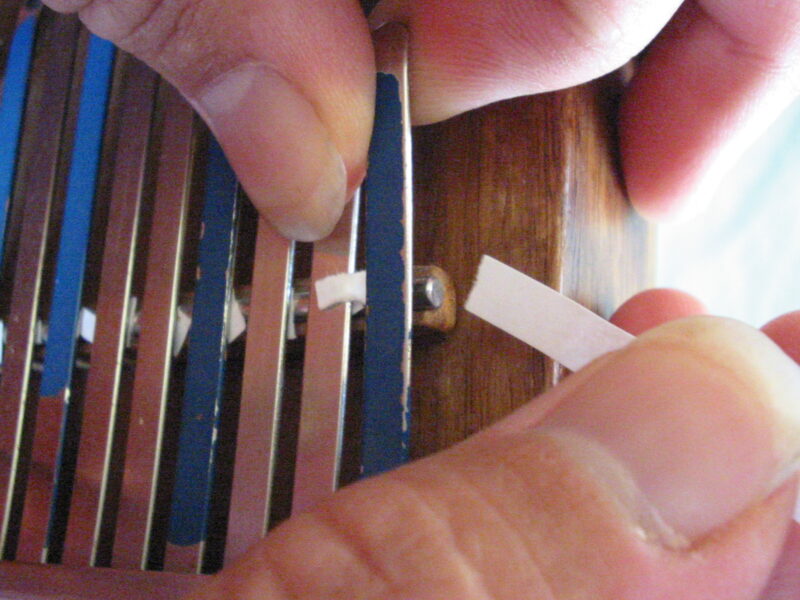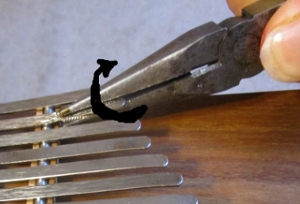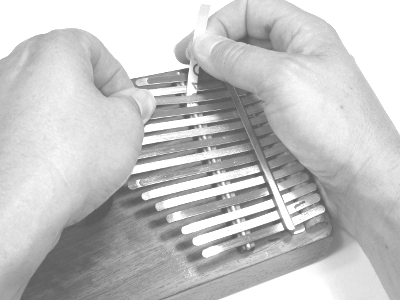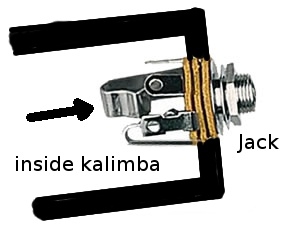Most people who have played kalimba for a month or more have come to know the buzzing that can occur on a few notes on the kalimba. You aren’t familiar with the buzz? Check out Taj Mahal playing on the Flip Wilson Show in 1973, which introduced many to the kalimba. These particular buzzes aren’t too bad as buzzes go. Listen for two cranky notes among the upper notes on both the left and right sides. When Taj plays the samba beat at about 1:00 in the video, listen for the buzz of the low G and A notes. These definitely detract from his otherwise stellar performance. (O, I could make that kalimba sing for Taj if I only had the chance. Keep on dreaming, Mark…)
One day the buzz will appear out of the blue – it is strange how that happens. While the Africans love the buzzing sound, and even go to great lengths to include shells or bottle caps on their kalimbas to make them buzz, most western ears don’t appreciate the buzzing, especially if it’s happening on only a few of the notes and the rest ring clear. Fortunately, there are several ways you can fix the buzzing.
Often a buzz can be fixed by shifting the buzzy tine to the left or the right. If this doesn’t do it, try moving and pushing the tine down, grinding it a bit into the bridge, as you shift it. If this method works, the buzz will probably go away while the tine is shifted away from its original position but will probably return if the tine is back in its original position. So if you end up moving a tine pretty far from its original spot, you must then also move the neighboring tines to get them all evenly spaced again. If you try all this and still have buzz problems, go on to the “paper washer method”.

Cut a piece of regular office paper into a strip about 1/8 inch by 1 inch. Lift the buzzy tine up and off of the bridge rod, and slide the tip of your paper strip in between the tine and bridge rod. Lower the tine until it traps the paper, and then tear off the excess paper. This technique works very well for the lower 2/3 of the kalimba, but less well for the upper notes (with shorter tines), as it seems to deaden their sound too much.

The backstop on the Hugh Tracey kalimba is a half round strip of wood, on which the tines rest at the head of the kalimba. The tines are under considerable tension here. They can compress part of the wood. If the tine is sitting partly on compressed and partly on uncompressed wood on the half round, this can result in a tine that is tilted a bit and consequently does not rest perfectly flat on the bridge.
If the previous solutions have not done the trick, take a pliers and grasp the business end (the end you play) of the buzzy tine and torque the tine, hopefully in the opposite direction from where it currently rests (which sort of mashes some of the wood on the backstop) to try and get it closer to level. Pluck the tine and listen. If twisting the tine made the buzz worse, twist it the opposite direction, and do not be afraid to twist the tine more than once.

A different way to help a buzzing tine lay flat and ring clear is to smooth the surface of the bridge, which is the fat, silver colored wire upon which the tines rest. Cut a little piece of fine sand paper (about 400 grit per inch), lift the buzzy tine, and slip the sandpaper between the tine and the bridge, sand-side down – don’t sand the tine. If you allow the tine to go down all the way, when you pull on the sandpaper, it will tear. Instead, lift the tine slightly such that it is still holding the sand paper in place. Then pull the sandpaper and it will grind away the imperfections of the bridge surface. After a few times, upgrade to the finest grit sand paper you can get – in my case, 1000 grit.

If your kalimba has a pickup, consider this rare situation: if there is one note that buzzes badly, and it stops buzzing when you insert a guitar cord plug into the jack, the buzz is due to a piece of the output jack inside the kalimba vibrating sympathetically with that one tine. Reach a finger inside the sound hole and, while you pluck that tine, touch the long thin piece of metal that is a part of the pickup. Does the buzzing stop when your finger touches this internal piece of metal? If it does, try pushing it around a bit and see if you can make the buzzing stop. You will be bending the metal a bit when you push it.
When the buzzing stops, check to make sure the pickup still works. If this problem remains, or if you have compromised the pickup, return the kalimba to Kalimba Magic and, as long as the kalimba was purchased less than a year before, the pickup will be replaced free of charge.
Also, the hexagonal ring that screws onto the outside of the jack sometimes will come loose, and can rattle. This rattle will stop when you tighten the hexagonal ring. If it comes loose again, remove it, put a dab of crazy glue on the jack, and then put the hexagonal ring on again and tighten it, and this time it will be glued down for good.
If you have a buzz that you just can’t fix with any of these methods, you might want to consider
the Kalimba Doctor – if your kalimba is brand new, we’ll be embarrassed and fix it for free. (I suspect the buzzes sometimes develop from rough handling in shipping.)


Sign up for our newsletter and free resources with your email address:
We pinky promise not to spam you and to only send good stuff.
 Christmas in July 2025
Christmas in July 2025 Patriotic and American Music for Kalimba
Patriotic and American Music for Kalimba